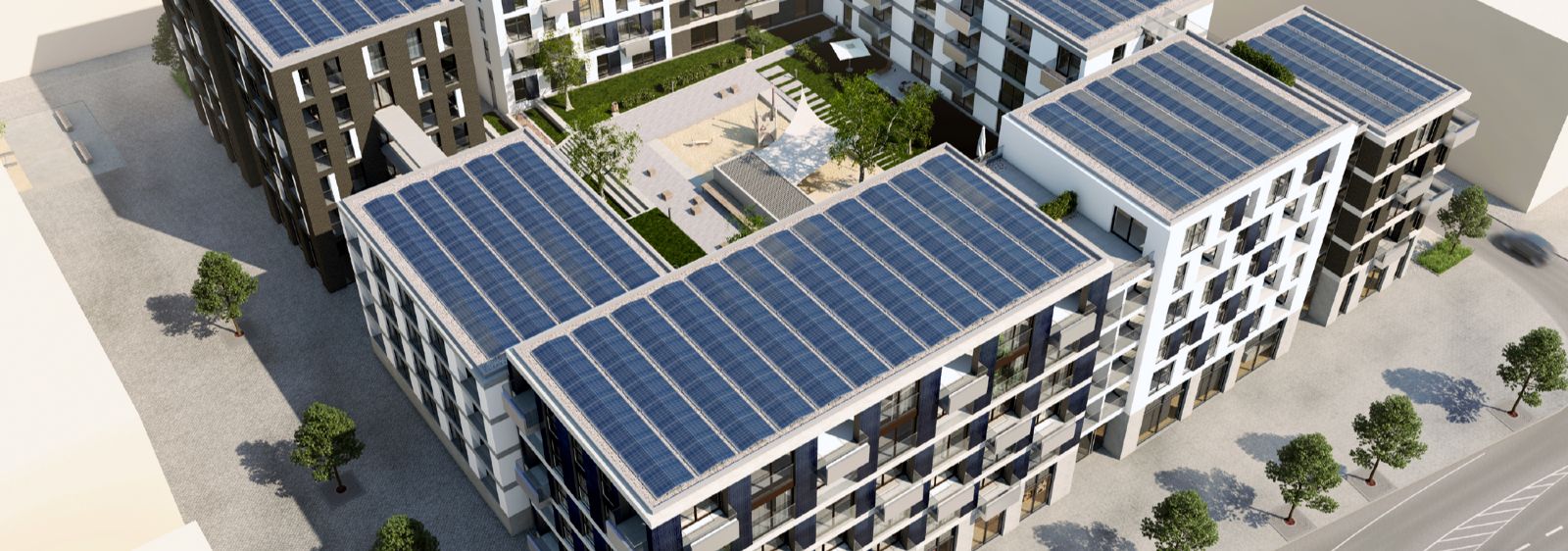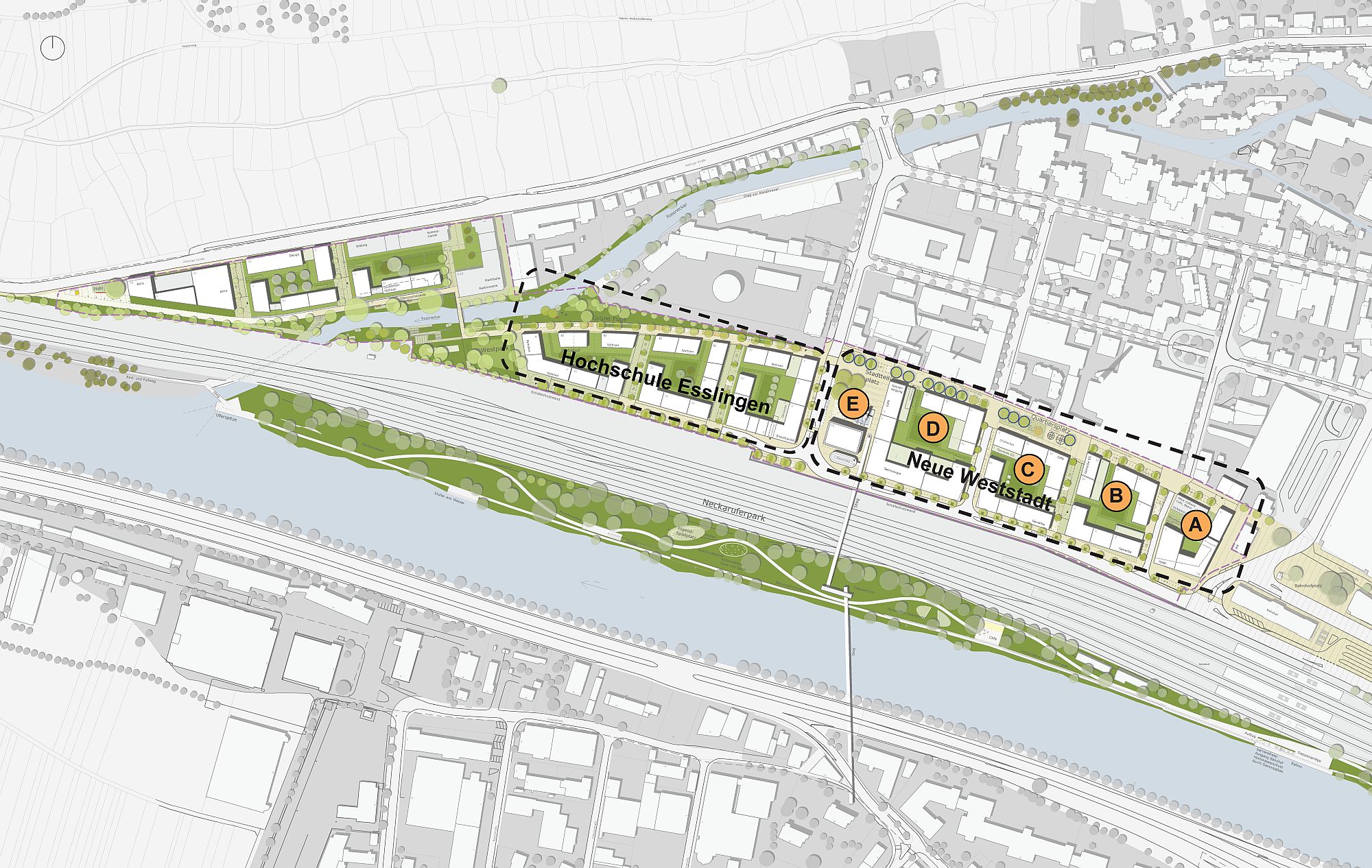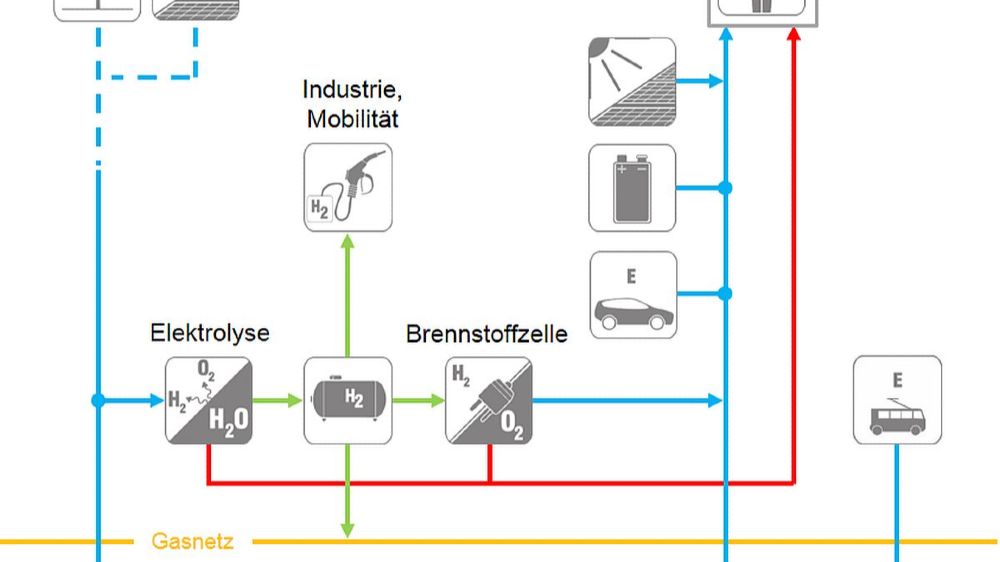
Climate-neutral district
Hydrogen for the urban energy transition
A new, almost climate-neutral city district is being built on a former freight station site in Esslingen. Over a period of five years, scientists are testing an innovative energy supply concept in the planned "Neue Weststadt" district, in which surplus electricity from fluctuating renewable energies is stored as hydrogen and fed back into the grid when required. The district also serves as a real laboratory for the systemic coupling of the heating, cooling, electricity and mobility sectors.
The "Neue Weststadt" urban district is being built on an area of around 12 hectares directly on the Neckar River and comprises over 600 apartments, office and commercial space as well as a new building for Esslingen University of Applied Sciences. The plans are based on an urban planning competition held in 2011. Construction of individual building blocks began in 2016 and will be completed by around 2022.
The research project builds on the findings of a preparatory study in which the necessary foundations for a climate-neutral city district were worked out. During the implementation of the concept, concrete solutions for the use of regeneratively generated electricity surpluses and waste heat will be applied. The coupling of the various sectors such as electricity, heating, cooling and mobility should relieve supraregional supply structures and enable climate-neutral supply to the district.
Particular attention is paid to grid operation and balancing group optimisation when purchasing surplus electricity from renewable sources. The use of grid- and market-based surpluses contributes to adjusting the increasing peaks in generation and load in the electricity sector to each other. With the further expansion of renewable energies, measures to stabilise the electricity grid are becoming increasingly important in order to integrate them into the electricity grid and guarantee renewable supply security.

Electrolyser produces hydrogen in the district
The technical potential for regenerative electricity production on site is exploited as far as possible. However, due to the high building density, these are not sufficient to cover the entire demand on the balance sheet. In order to provide this amount of energy and to relieve the power grid, surplus electricity is purchased from renewable energies, which could possibly not be used. In order to supply a district with these fluctuating surpluses, interim storage of the electricity is necessary, for example in the form of hydrogen. This task is performed in the district by an electrolyser located in the energy centre. Most of the hydrogen produced is fed into the existing natural gas network, which serves as a long-term storage facility. Climate-neutral hydrogen can also be used in mobility to decarbonise the mobility sector. If power is required in the grid, power can also be fed back into the grid. As a result, the renewable surplus electricity is used to stabilise the grid. In addition, the waste heat generated during the conversion processes is to be fed into a local heating network and used in the district.

Energy for systemic mobility
The district will receive a comprehensive range of e-charging stations both for private vehicles and for internal car sharing. The plan is to interconnect the loading and booking technology of the vehicles and to implement systematic operation. In the future, it should also be possible to feed energy from the vehicles back into the neighbourhood network.
Today, electric trolleybuses already provide about 30% of public transport in Esslingen. In the course of the project, electric buses are also to replace other diesel buses in the fleet. Since the trolley system cannot be completely removed, trolleybuses with additional batteries are necessary. These hybrid electric buses can quadruple the number of electrically driven routes if the overhead lines are expanded by 20%.
Social scientific and technical monitoring
Success and transferability of the project depend decisively on the acceptance of the different user groups. For this reason, social science monitoring accompanies the transformation process on the former freight station site in order to identify and take into account the wishes and satisfaction of the citizens at an early stage. With the help of a detailed communication concept, comprehensive and transparent information about the project and the new technologies used shall also be provided. The aim is not only to provide proof of functionality and suitability for everyday use with regard to a future energy system applicable throughout Germany, but also to document it in a comprehensible manner. The project structure of local and national network partners and the exemplary settlement and use structure of the "New Weststadt" offers the opportunity to transfer the results to other cities and municipalities.
Funding initiative for Solar Building/Energy Efficient City
The joint project "EnStadt-Es_West_P2G2P: Climate Neutral City Quarter Neue Weststadt Esslingen" is one of six lighthouse projects of the Federal Ministry of Economics and Energy (BMWi) and the Federal Ministry of Education and Research (BMBF) funding initiative Solar Building/Energy Efficient City launched in 2016. The project consortium consists of 10 partners. The overall coordination and scientific management is carried out by Steinbeis Innovationszentrum Energie-, Gebäude- und Solartechnik (SIZ-EGS), Stuttgart.

